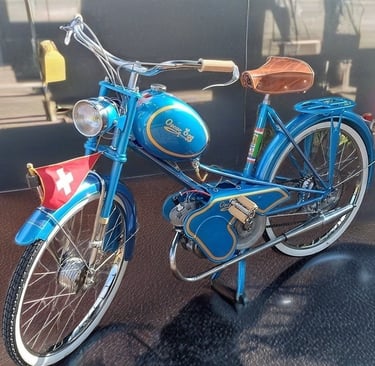Oscar EGG Model H Moped: A Chronicle of Swiss Innovation and the Evolution of Power
The article discusses the significance of the Oscar EGG Model H moped in the evolution of Swiss personal mobility. It explores how Oscar Egg, a renowned Swiss racing cyclist, used his innovative mindset to create a moped that incorporated early VAP two-stroke engines and later transitioned to Ducati Cucciolo four-stroke engines. The moped's design and performance showcased a commitment to excellence, and Egg's ability to adapt and introduce cutting-edge technologies left a lasting impact on the history of Swiss mopeds.
SWITZERLAND CYCLEMOTORSTWO STROKEMOTORIZED BICYCLES
2/21/20242 min read


Oscar EGG Model H Moped: A Chronicle of Swiss Innovation and the Evolution of Power
Introduction
Oscar Egg, celebrated both as a Swiss racing cyclist and an innovative mind, left an indelible mark on the post-war European landscape. Beyond his cycling triumphs, Egg's contribution extends to the realm of motorized two-wheelers. The 1955 Oscar EGG Model H moped emerges as a testament to his inventive spirit and its pivotal role in the evolution of Swiss personal mobility. This narrative delves into the moped's significance, tracing its journey from early VAP two-stroke engines to the later adoption of Ducati Cucciolo four-stroke engines.
Historical Context and Early Innovations
In the mid-20th century, Europe sought novel solutions for affordable and practical mobility post-war. Oscar Egg responded by harnessing his cycling expertise, introducing the Model H moped. This two-wheeler, equipped with early VAP two-stroke engines, became a symbol of quality and resilience. Egg's cycling legacy infused the moped with reliability and performance, meeting the populace's demand for a forward-thinking mobility solution.
Technical Mastery and Engine Evolution
The Model H's technical prowess is exemplified by its early use of VAP two-stroke engines, showcasing Egg's commitment to precision. These engines, efficient and reliable, propelled the moped into a new era of personal transportation. As times evolved, so did Oscar Egg's vision. The later incorporation of Ducati Cucciolo four-stroke engines marked a significant shift, bridging the gap between traditional cycling and a more sophisticated motorized experience. This transition underscored Egg's adaptability and his pursuit of innovative solutions to meet changing mobility needs.
Design and Performance
Meticulously engineered, the Oscar EGG Model H epitomized the harmonious marriage of form and function in industrial design. Beyond its aesthetic appeal, the moped's early reliance on VAP two-stroke engines and later integration of Ducati Cucciolo four-stroke engines showcased a commitment to performance. The shift to four-stroke engines represented a technological leap, providing a smoother and more efficient riding experience while maintaining Egg's standard of excellence.
Legacy and Lasting Impact
Oscar Egg's legacy transcends cycling victories; it encompasses his pioneering role in shaping the narrative of Swiss personal mobility. From the early reliance on VAP two-stroke engines to the later adoption of Ducati Cucciolo four-stroke engines, Egg's Model H moped reflects a dynamic journey through the evolution of power and innovation. His ability to adapt and introduce cutting-edge technologies underscores his lasting impact on the history of Swiss mopeds.
